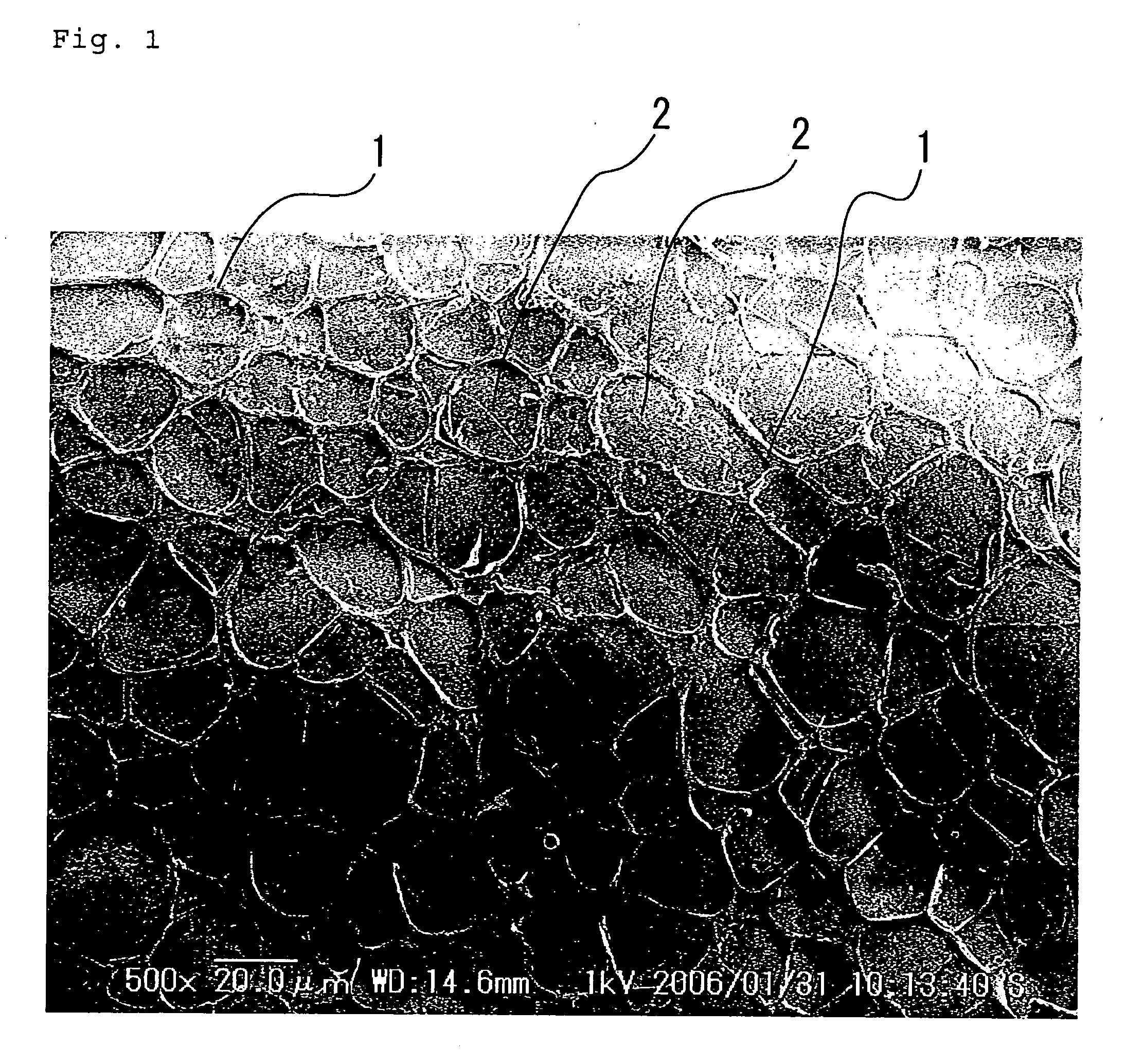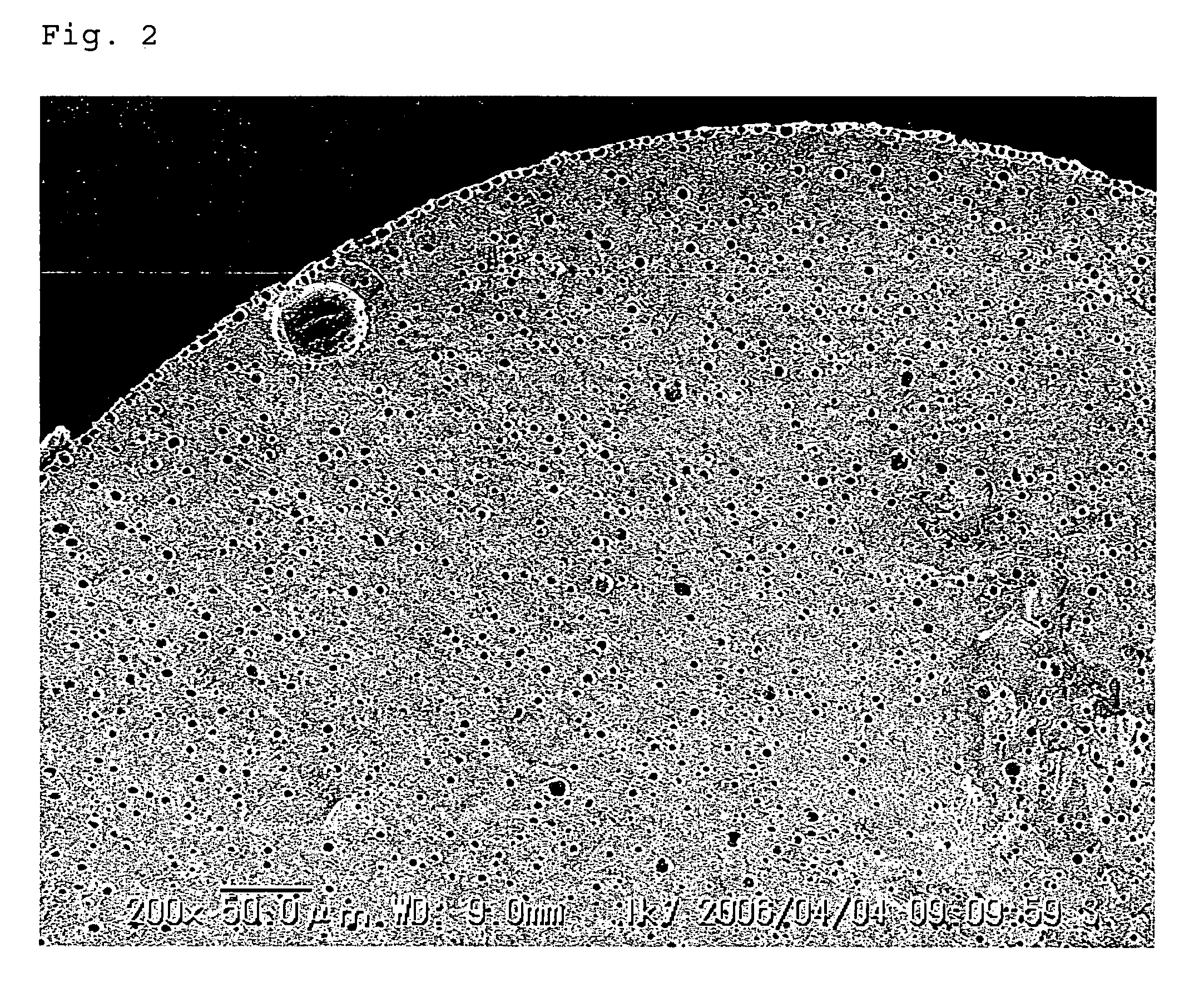Acrylic resin expanded beads, acrylic resin expandable beads, and method for manufacturing foamed molded article of acrylic resin expanded beads
a technology acrylic resin, which is applied in the field the method of manufacturing the foamed molded article of acrylic resin expanded beads, can solve the problems of reducing productivity, difficult manufacturing of models, and extremely long cooling time, and achieves short cooling time, excellent fusibility, and improved molding cycle
- Summary
- Abstract
- Description
- Claims
- Application Information
AI Technical Summary
Benefits of technology
Problems solved by technology
Method used
Image
Examples
example 1
[0075]430 kg of deionized water, 0.4 kg of tertiary calcium phosphate (made by Taihei Kagaku Sangyo; used as a suspension agent), 70 g of disodium dodecyldiphenyl ether sulfonate (Pelex SSH, made by Kao, 50% aqueous solution; used as a surfactant), and 0.65 kg of sodium acetate (used as electrolyte) were poured into an autoclave with an internal volume of 1 cubic meter and equipped with a stirrer. Next, 1.5 kg of benzoyl peroxide (Nyper BW, made by NOF Corp., water-diluted powder) and 0.4 kg of t-butyl peroxy-2-ethylhexylmonocarbonate (Perbutyl E, made by NOF Corp.) (both used as polymerization initiators), 3.1 kg of liquid paraffin (Moresco White P60, made by Matsumura Oil Research, average carbon number of 20; used as a mesh forming agent), and 0.6 kg of α-methylstyrene dimer (Nofiner MSD, made by NOF Corp.; used as a chain transfer agent) were dissolved in 233 kg of methyl methacrylate, 56 kg of styrene, and 22 kg of α-methylstyrene, and this solution was poured into the autoclav...
example 2
[0086]The same test as in Example 1 was conducted, except that 3.1 kg of liquid paraffin (Moresco White P150, made by Matsumura Oil Research, average carbon number of 25) was used as a mesh forming agent. The results are shown in Table 1. Scanning electron micrographs of the surface and cross section of the acrylic resin expandable beads and the surface of the expanded beads obtained in Example 2 are shown, respectively, in FIG. 10 (magnified 3000 times), FIG. 11 (magnified 1000 times), and FIG. 12 (magnified 500 times).
example 3
[0087]The same test as in Example 1 was conducted, except that 3.1 kg of liquid paraffin (Moresco White P350P, made by Matsumura Oil Research, average carbon number of 33) was used as a mesh forming agent. The results are shown in Table 1. Scanning electron micrographs of the surface and cross section of the acrylic resin expandable beads and the surface of the expanded beads obtained in Example 3 are shown, respectively, in FIG. 13 (magnified 3000 times), FIG. 14 (magnified 1000 times), and FIG. 15 (magnified 500 times).
PUM
| Property | Measurement | Unit |
|---|---|---|
| Length | aaaaa | aaaaa |
| Percent by mass | aaaaa | aaaaa |
| Size | aaaaa | aaaaa |
Abstract
Description
Claims
Application Information
 Login to View More
Login to View More - R&D
- Intellectual Property
- Life Sciences
- Materials
- Tech Scout
- Unparalleled Data Quality
- Higher Quality Content
- 60% Fewer Hallucinations
Browse by: Latest US Patents, China's latest patents, Technical Efficacy Thesaurus, Application Domain, Technology Topic, Popular Technical Reports.
© 2025 PatSnap. All rights reserved.Legal|Privacy policy|Modern Slavery Act Transparency Statement|Sitemap|About US| Contact US: help@patsnap.com



